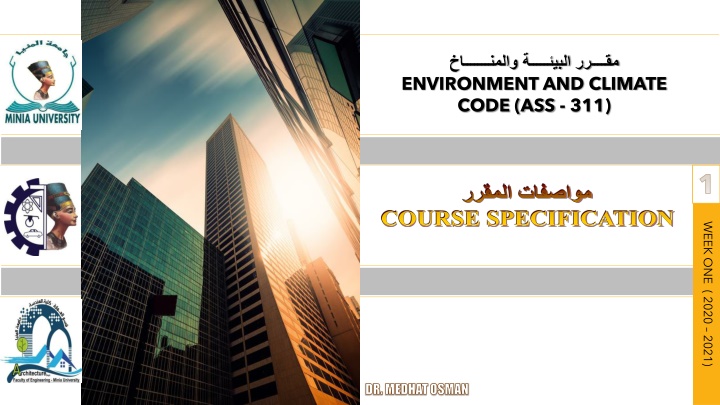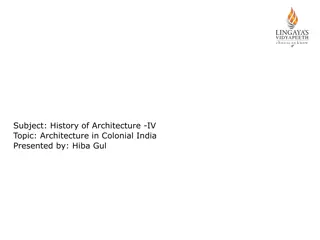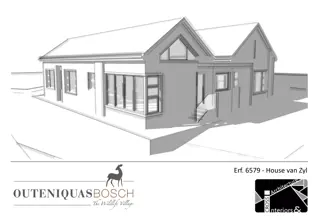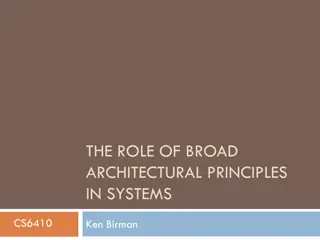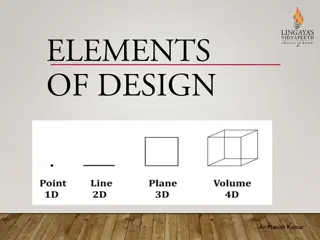Environmental Factors in Architectural Design
This course focuses on the study of environmental factors influencing architectural design and planning, with an emphasis on climatic conditions, solar radiation, natural ventilation, and sustainable design principles. Students will learn about climate elements, thermal comfort, sustainable design principles, simulation modeling, and strategies for climatic control in buildings. The course covers topics such as climatic design regions, sun-earth relationship, and air movement in architectural and urban design.
Download Presentation

Please find below an Image/Link to download the presentation.
The content on the website is provided AS IS for your information and personal use only. It may not be sold, licensed, or shared on other websites without obtaining consent from the author.If you encounter any issues during the download, it is possible that the publisher has removed the file from their server.
You are allowed to download the files provided on this website for personal or commercial use, subject to the condition that they are used lawfully. All files are the property of their respective owners.
The content on the website is provided AS IS for your information and personal use only. It may not be sold, licensed, or shared on other websites without obtaining consent from the author.
E N D
Presentation Transcript
ENVIRONMENT AND CLIMATE CODE (ASS - 311) 1 COURSE SPECIFICATION WEEK ONE ( 2020 2021) DR. MEDHAT OSMAN DR. MEDHAT OSMAN
1- Overall Aims of the Course Overall Aims of the Course Study of environmental factors affecting the architectural design & planning Emphasize the climatic conditions and their important role as one of the environmental factors Emphasize the important role of solar radiation and natural ventilation as of major climatic elements affecting architecture and urban design Illustrate how the architecture and urban pattern in different desert settlements reflect the variations of the climatologically conditions. .
2-Intended Learning Outcomes (ILOs) of the course a. Knowledge and understanding: Upon completing this course, the student should be able to: a1- Define different climate elements. a2 Demonstrate Thermal comfort factors, measures and human body thermal equilibrium. a3- Identify principles of sustainable design, climatic considerations and energy consumption and efficiency in buildings and their impacts on the environment. a4- Use physical and computer simulation modeling. b- Intellectual skills Upon completing this course, the student should be able to: b1- Analyze climate condition results of numerical models and appreciate their limitations. b2- Predict building performance in different contexts. b3 Asses strategies of climatic control. b4- Think in a creative and innovative way in solving environmental design problems. c- Professional and practical skills Upon completing this course, the student should be able to: c1- Use simulation programs. c2-Apply knowledge of thermal performance and comfort strategies in buildings treatment. c3- Process data from numerical modelling. d- General and transferable skills Upon completing this course, the student should be able to: d1- communicate effectively using written, oral and graphical presentational skills. d2-use information technology, IT, effectively d3-organize plans for jobs and have a time table for each activity.
3- Course Syllabus CHAPTERS CONTENTS Chapter (1) An introduction to the course Chapter (2) An Introduction to Thermal Comfort in Buildings Chapter (3) Climatic Design Regions Chapter (4) Diagnosing Climate for Climatic Responsive Design (Mahony tables) Chapter (5) Sun-Earth Relationship: Scientific Background Chapter (6) How to Deal with Sun in Architectural Design (1) Chapter (7) How to Deal with Sun in Architectural Design (2) Chapter (8) The Scientific Background of Air Movement Chapter (9) How to Deal with Air in Architectural and Urban Design (1) Chapter (10) How to Deal with Air in Architectural and Urban Design (2)
4- Teaching, learning and assessment methods Teaching and Learning Methods Lectures Discussions Reports Assessment Methods Weight Written mid-term exam (5) marks out of (50) = 10% Written reports (5) marks out of (50) = 10% Written final exam (40) marks out of (50) = 80%
5- Course Timetable CHAPTERS CONTENTS Week (1) An introduction to the course Week (2) An Introduction to Thermal Comfort in Buildings Week (3) Climatic Design Regions Week (4) Diagnosing Climate for Climatic Responsive Design (Mahony tables) Week (5) Training: Mahony Tables Application on Egyptian Context Week (6) Sun-Earth Relationship: Scientific Background Week (7) How to Deal with Sun in Architectural Design (1) Week (8) How to Deal with Sun in Architectural Design (2) Week (9) Mid-Term Written Exam Week (10) The Scientific Background of Air Movement Week (11) How to Deal with Air in Architectural and Urban Design (1) Week (12) How to Deal with Air in Architectural and Urban Design (2) Week (13) Discussion Office Meeting Individually (If Needed) Week (14) Discussion Office Meeting Individually (If Needed)
6- Course References Text Books 1- Brown, G.Z. and M. Dekay, Sun, wind and light : Architectural design strategies. 2nd ed. 2001, New York ; Chichester: John Wiley & Sons, Inc. 2- Givoni, B., Man, Climate and Architecture. Second eddition ed. Architectural science series, ed. H.J. Cowan. 1976, London: Applied science publishers LTD. 3- McMullan, R., Environmental science in building. 6th ed. ed. Building and surveying series. 2007, Basingstoke: Palgrave Macmillan 4- Szokolay, S.V., Introduction to architectural science: The basis of sustainable design. 2nd ed. 2008: Elsevier Ltd. Other Sources 1- Mohamed, M., Investigating the environmental performance of government primary schools in Egypt: With particular concern to thermal comfort, in Dundee School of Architecture. 2009, University of Dundee: Dundee - Uk. 2- Gado, T. and M. Osman, Investigating natural ventilation inside walk-up housing blocks in the Egyptian desert climatic design region. International journal of ventilation, 2009. 8(2): p. 145-160. 3- Gado, T., M. Mohamed, and M. Osman, Investigating the intelligence of the low-tech earth architecture of the Sahara: A feasibility study from the western desert of Egypt. Intelligent Buildings International 2010. 2(3): p. 179-197 4- Gado, T. and M. Osman, Investigating traditional natural ventilation methods used in El-Dakhla Oasis, old village. Intelligent Buildings International 2010. 2(4): p. 267-285. 5- Osman, M., Evaluating and enhancing design for natural ventilation in walk-up public housing blocks in the Egyptian desert climatic design region, in Dundee School of Architecture. 2011, University of Dundee: Dundee - Uk. 6- Gado, T. Environmental design lectures in Dundee School of Architecture. 2011, University of Dundee: Dundee - Uk.
THANKS SEE YOU NEXT LECTURE
